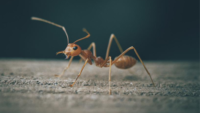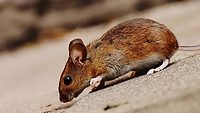Common Pests in Restaurants and How to Deal With Them—Part 2

Credit: PublicDomainPictures via Pixabay
Pest infestations in restaurants have been repeatedly linked to foodborne illness outbreaks. Pests are a major source of concern for restaurant operators because they put food safety at risk by transmitting disease-causing pathogens and contaminating food. Pest infestations can have a significant financial impact on a restaurant, resulting in revenue loss, higher treatment costs, loss of customer confidence, and food waste.
Part 2 of this two-part article series examines methods for addressing and preventing infestations by rodents, stored product insects, and mosquitoes. It also examines chemical and non-chemical treatment options available to restaurant operators for controlling or eliminating an existing infestation of these pests.
Rodents: Rats and Mice
Rats and mice are among the most prevalent pests encountered in restaurants. The most common rodents found in foodservice establishments are the Norway rat, roof rat, and house mouse. Norway rats are about 16 inches long, brown in color, and have a lifespan of about two years. Roof rats, on the other hand, have a one-year lifespan, are about 7 inches long, and are dark brown to black in color. House mice, which are about 3 inches long and grey to brown in color, can live for two to three years.
Rodents become active at dawn and dusk, and they are most active at night. They breed in temperatures ranging from 65–80 °F and spread a number of diseases through their feces and urine. Hantavirus pulmonary syndrome, leptospirosis, tularemia, and salmonellosis are few illnesses caused by rats and mice. The lifecycle of a rodent includes a gestation period, birth, weaning, and maturation into adults in about three weeks. Rodents prefer dark and moist environments, such as piles of cardboard and garbage and leaking plumbing fixtures, and they frequently seek refuge in warm spots. Notably, they can gnaw and chew through cardboard and fixtures to construct nests.
Rodents gain access to restaurants via cracks and holes in the walls, doors, roof, and exhaust vents. Once inside, they conceal themselves in drains and sewers, false ceilings, and waste piles. They are attracted to human food, areas with standing water, and garbage. Once inside a restaurant, they multiply quickly and contaminate food, surfaces, cooking equipment, and utensils.
Signs of Infestation
Signs of rodent infestation include:
- Chew marks on food packaging, cardboard, and other materials
- Strong, foul odor
- Rotting odor, if dead rodents are present
- Presence of small, dark brown droppings with pointed ends
- Sounds of gnawing and scratching are frequently heard in areas infested by rodents.
Hot Spots for Rodents
Some of the hot spots for rodents include:
- Broken roofs, ceilings, and walls
- Gaps in doors and windows
- Poorly maintained and overflowing trash cans
- Dirty dishwashing sinks and storage cabinets
- Broken and leaking plumbing lines
- Open sewage.
Measures to Prevent Rodent Infestation
Rodent prevention in a foodservice establishment encompasses several actions:
- Install door sweeps and door closures on the front and back doors to keep rodents out
- Screen windows and exhaust vents, and repair damaged screens to prevent rodents from getting in
- Seal holes on walls with a caulking agent
- Fix leaking pipes and clogged drains in the kitchen and bar areas, and keep drains clean and covered at all times
- Do not leave soiled dishes in sinks overnight
- Clean up all food and drink spills immediately
- Look for signs of rodent damage on cardboard and food packaging.
Non-Chemical and Chemical Treatments
One non-chemical treatment for rat infestation is the use of an electronic trap that kills rodents by giving an electric shock. A snap trap is another non-chemical device that uses a spring-loaded bar to kill rodents that come into contact with the trap. A glue trap is another approach, but the hazards of using a glue trap outweigh its benefits. The adhesives in glue traps cause rats to die in agony, and they may urinate or defecate while being captured, increasing the risk of pathogen spread.
Rodent bait could be used as a chemical treatment approach. It contains either chronic (slow-acting) or acute (fast-acting) rodenticides like brodifacoum or zinc phosphide, both of which are toxic to rodents. The great majority of rats that consume brodifacoum die within one to two days of returning to their nests. Zinc phosphide is extremely toxic to rats and kills them within a few hours of consumption. The bait station must be strategically located between the probable nests and the food source. Another chemical technique that can be used is to kill rats by fumigating infested areas, like storerooms, with phosphine gas. Fumigation is a fast and effective way to eliminate rat infestation throughout a facility.
Stored Product Insects
Stored product insects such as Indianmeal moths, bean weevils, flour beetles, and red flour mites are a significant source of worry for restaurants. Indianmeal moths range in size from 4 mm to 30 cm; are brown, grey, or black in color; and have a lifespan of three to six months. Bean weevils range in size from 3 mm to more than 10 mm and are dark brown or black in color. Flour beetles are 3–4 mm long and brown or black in color. Red flour mites range in size from 0.1 mm to 6 mm and are red, blue, or brown in color.
These insects forage for food at night and reproduce rapidly, resulting in massive numbers. Moths have been observed infesting grains and nuts, while beetles and weevils have been observed infesting flour, spices, and cereals, and mites are known to infest fruits, vegetables, and cereals. These pests enter food packaging through small openings or can gnaw through packaging and other materials, such as cling wrap, to reach stored food items. It is not unusual to find them nesting in food containers. They contaminate food with their eggs, feces, and cocoons, turning stored food items like cereals into fine powder or altering the flavor and quality, rendering the food unfit for human consumption. They make holes in whole grains, where they lay their eggs.
The lifecycle of stored product insects, such as beetles and moths, begins with an egg stage, followed by several larvae in four to 16 weeks, pupae in one to three weeks, and finally an adult stage. They have a lifespan of three to 24 weeks. These pests enter the restaurant as eggs or larvae through infested supplies or delivery crates.
Signs of Infestation
The following signs are indicators of a stored product insect infestation:
- Regular sightings of weevils, beetles, and moths crawling on walls, floors, and surfaces or flying in kitchen and service areas
- Presence of irregular holes in whole grains and other food items
- Physical damage to food packaging
- Sightings of insects in food storage containers.
Measures to prevent SPI Infestation
The following measures can be taken to prevent stored product insect infestation:
- Store food items in airtight containers
- Work closely with a pest control provider and regularly inspect possible entry points
- Keep facility exteriors in sanitary condition and free of tall bushes, trees, and stagnant water
- Clean up all food and drink spills immediately
- Empty and clean waste bins regularly, and keep areas in and around dumpsters clean
- Do not leave soiled dishes in sinks overnight
- Keep windows and doors shut, and fix any gaps or holes
- Watch incoming products and delivery crates for signs of pest infestation
- Install fly screens
- Keep food storage spaces at the ideal temperature, and keep relative humidity low (40–45 percent) to prevent these pests from producing eggs.
Non-Chemical and Chemical Treatments
Installing insect light traps is one non-chemical treatment available to restaurant operators. These traps use ultraviolet light to attract insects. When the insects are drawn to the trap, they become stuck on the glue board and die.
Spraying dichlorovinyl dimethyl phosphate is a chemical treatment option available to restaurant operators to control infestation by stored product insects. It is imperative to note that dichlorovinyl dimethyl phosphate is harmful to humans, and it should be used with extreme caution and in line with all safety measures and guidance for application. Some governments have prohibited its use due to the risk to human health. Smoke bombs are another common chemical treatment used to kill moths, beetles, and weevils. Pyrethin is the active ingredient in smoke bombs. It should be noted that they are effective against adult moths, but not against hidden larvae.
Mosquitoes
Mosquitoes are another common insect encountered in restaurants. They are gray in color, live for up to two months, and range in size from 2–15 mm. Female mosquitoes lay eggs, which hatch into larvae and then mature into pupae before maturing into adults—a cycle that takes approximately 8–10 days. The majority of mosquitoes are active at night, although some are also active during the day. Mosquitoes are most active during the summer months and thrive in temperatures above 80 °F. They rest on plants, sewers, walls, and under and behind furniture.
Mosquitoes feed on human and animal blood and are also attracted to sugary substances like fruits and sweet drinks. Mosquitoes have been linked to the spread of diseases such as malaria, Zika virus, West Nile virus, and dengue fever, all of which can be transmitted to people by a mosquito bite. Mosquitoes prefer dark, wet environments, where they will lay eggs. They can enter a restaurant through open doors and windows, as well as through gaps or holes in window and door screens.
Signs of Infestation
Some signs of a mosquito infestation include:
- Regular sightings of mosquitoes in the kitchen or service areas
- Constant high, buzzing sound
- Personnel reporting mosquito bites while at work
- Egg deposits near a water source that look like floating debris.
Measures to Prevent Mosquito Infestation
Some measures to prevent mosquito infestation include:
- Remove pooled water on floors, at the intersections of walls and floors, and at the junctions of floors and drains
- Ensure that there is no stagnant water in flower pots
- Fix leaking faucets and plumbing leaks
- Empty garbage cans regularly and keep dumpsters clean and covered
- Keep restaurant exterior free of bushes, debris, litter, and standing water.
Non-Chemical and Chemical Treatments
Installing an insect killing machine that uses ultraviolet light to catch mosquitoes in service and kitchen areas is one non-chemical treatment that can be used to eliminate a mosquito infestation. Keep in mind that the location of the machine must be carefully considered. Another option is to install a propane-powered mosquito trap, which is a preferred mosquito infestation control method. It captures mosquitoes by producing smells that attract mosquitoes to the trap. When they are drawn to the trap, they are vacuumed within, trapped, and eventually perish. The catch net in the trap must be replaced according to the manufacturer's instructions.
Chemical control methods utilize chemicals that kill mosquitoes by disrupting their neurological systems. Larvicides, which are available in pellets and granules, are one of the chemical treatment options. Larvicide contains a bacterial toxin and/or s-methoprene, which kills mosquito larvae. To be effective, larvicide is often applied in smaller regions and at specific stages of the mosquito lifecycle. Smoke-repellent mosquito bombs with permethrin are also available to treat mosquito infestation.
Water-based insecticide fogging solutions that have pyrethrin as an active ingredient are other environmentally friendly chemical treatments that restaurant operators can consider. Note that permethrin is a synthetic chemical, whereas pyrethrum is a naturally occurring pesticide obtained from chrysanthemum flowers. The effects of both insecticides are similar. It is critical to remember that pyrethrin degrades when exposed to light and water, reducing its efficacy. Permethrin has a longer life than pyrethrin. They are both exceedingly harmful to aquatic organisms and must be used in such a way that there is no significant runoff into bodies of water.
Good Pest Control Requires Everyone's Help
Remember, employees are critical to the success of pest control efforts. They must be trained in pest monitoring so that they can assist in spotting pest activity and evaluating the success of the continuing treatment strategy by determining whether or not the pest population has decreased. It is also critical that restaurant operators collaborate with professional, licensed pest control specialists. This will help in identifying possible entry points and developing a pest treatment and control plan that is less hazardous to food and people. Another important factor to consider and address is the possible presence of pests on adjoining properties. Pests that invade foodservice establishment are sometimes triggered by pests on neighboring premises.
Restaurant operators must concentrate their efforts on maintaining a clean and hygienic environment, identifying and closing any potential pest entry points, and eliminating the sources of food, water, and shelter that pests require to survive. Chemical applications should be used only as a last resort in restaurant pest control. Non-chemical treatments are always the first choice (depending on the severity of the infestation), as they eliminate the potential introduction of chemicals into food preparation and service areas. This multimodal strategy will not only lower the risk to food and customers, but also reduce pesticide dependency, which will benefit the environment.
Pests are a major source of concern for restaurants due to the damage they can inflict on product, business, and reputation. When it comes to pests, prevention is always preferable to treatment.
Looking for a reprint of this article?
From high-res PDFs to custom plaques, order your copy today!






